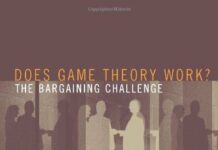
Ebook Info
- Published: 2008
- Number of pages: 214 pages
- Format: PDF
- File Size: 3.08 MB
- Authors: Ken Binmore
Description
It is widely held that Bayesian decision theory is the final word on how a rational person should make decisions. However, Leonard Savage–the inventor of Bayesian decision theory–argued that it would be ridiculous to use his theory outside the kind of small world in which it is always possible to “look before you leap.” If taken seriously, this view makes Bayesian decision theory inappropriate for the large worlds of scientific discovery and macroeconomic enterprise. When is it correct to use Bayesian decision theory–and when does it need to be modified? Using a minimum of mathematics, Rational Decisions clearly explains the foundations of Bayesian decision theory and shows why Savage restricted the theory’s application to small worlds. The book is a wide-ranging exploration of standard theories of choice and belief under risk and uncertainty. Ken Binmore discusses the various philosophical attitudes related to the nature of probability and offers resolutions to paradoxes believed to hinder further progress. In arguing that the Bayesian approach to knowledge is inadequate in a large world, Binmore proposes an extension to Bayesian decision theory–allowing the idea of a mixed strategy in game theory to be expanded to a larger set of what Binmore refers to as “muddled” strategies. Written by one of the world’s leading game theorists, Rational Decisions is the touchstone for anyone needing a concise, accessible, and expert view on Bayesian decision making.
User’s Reviews
Reviews from Amazon users which were colected at the time this book was published on the website:
⭐This is a must read as it presents a comprehensive set of the principles and axioms behind neo-classical economics. Binmore is a mathematician, hence everything is mapped properly, clearly, and thoroughly.I spent several days in a seminar with Binmore and was surprised to discover, from his arguments, that much of the criticism against the foundations of decision theory are strawman. For the theory doesn’t say what people think it says. It may have some problems (such as knowledge of probability and understanding of future payoffs) but not the problems discussed in the behavioral and heterodox literature that appear to be violated by people in their experiments.Binmore writes the following gem: “Nor does the theory [Revealed Preferences] insist that people are selfish, as its critics mischievously maintain. It has no difficulty in modeling the kind of saintly folk who would sell the shirt off their back rather than see a baby cry”.Binmore doesn’t say it explicitly, but hints that even the highly influential critiques of Amartya Sen in “Rational Fools” and elsewhere appear to be a bit strawmannish.The book is short and dense enough to be a reference.
⭐Binmore realizes that the current ,Bayesian decision theory approach,which is a generalization of Jeremy Bentham’s approach,based on the claim that all probabilities are subjective, unique,precise,exact,additive single number estimates ,as are all outcomes,has broken down.It can only be applied in Savage’s “small ” world, as opposed to the real world.On pp. 163-169,he proposes to use a variant of the lower-upper interval approach to probability that he credits to Good as a way of making Bayesianism more relevant and applicable.Binmore argues ,correctly,that Bayesianism can’t deal with uncertainty (p.35), as opposed to risk ,or ignorance (p.154).He presents a decent discussion of lower-upper probabilities on pp.88-93,although he has no idea at all that Keynes had already provided a much more broader discussion of such interval estimates in the A Treatise on Probability.However,we are then treated to the following summary,provided after Binmore categorically dismisses and rejects Keynes’s logical approach to probability ,which Keynes firmly anchored to his own modified version of Boole’s (The Laws of Thought,1854)original lower -upper probability approach in chapters 15,17,20,22,and 26 of the A Treatise on Probability in 1921 [the reader should note that this material is also in Keynes’s 1907 (unsuccessful) and 1908 (successful) Fellowship dissertations done at Cambridge]: “The prevailing orthodoxy in economics is Bayesianism,which I take to be the philosophical position that Bayesian decision theory always applies to all decision problems.In particular,it proceeds as though the subjective probabilities of Savage’s theory can be reinterpreted as logical probabilities without any hassle “(Binmore,p.96).Binmore is correct only in the very special case where Keynes’s weight of the evidence,w, specified on the unit interval from 0 to 1,is equal to 1.This is the case of linear risk.It means that there is no uncertainty or ignorance facing the decision maker,only risk.Binmore attempted to deal with uncertainty earlier in his book when he went over the Ellsberg Paradox,where Ellsberg’s ambiguity would be substituted for Keynes’s uncertainty from the GT or Keynes’s weight of the evidence,w, from the TP. In summary,Binmore has successfully reinvented the wheel.His suggested solution is inferior to that first presented by J M Keynes over a 100 years ago.Binmore,of course,is correct.What is amazing is his complete and total ignorance of the work in this area of J M Keynes . Most likely this is due to his accepting at face value two totally preposterous book reviews of Keynes’s TP written by the original Bayesian subjectivist,Frank Ramsey.These two book reviews,writtten in 1922 and 1926,respectively,are the source of the prevalent, incorrect claims that Keynes used ” non-numerical ” probabiities and that these non-numerical probabilities involved no numbers at all except in the few, very special cases where the principle of indifference could be applied.This makes no sense at all today or in 1922 or 1926.
⭐It be gooder.
⭐If I were better at making rational decisions, I would neither have purchased this book, nor wasted my time reading it. Ken Binmore and his heroine Pandora manage to delve into some sort of quest for the hair-splitting mathematical minutiae underlying decision making, especially Bayesian decision making, without coming remotely close to discussing important issues of how one should make rational decisions in the real world. Unless you are a desperate PhD candidate in search of an obscure topic on which you can pontificate, avoid this book.
⭐This book is probably one of the best book you can read about rational decision theory. If you are a graduate student of a PhD candidate in economics, you should really give it a look.Nevertheless, this book is maybe harsh for undergraduate students, of people with a weak background in math.
Keywords
Free Download Rational Decisions (The Gorman Lectures in Economics Book 4) in PDF format
Rational Decisions (The Gorman Lectures in Economics Book 4) PDF Free Download
Download Rational Decisions (The Gorman Lectures in Economics Book 4) 2008 PDF Free
Rational Decisions (The Gorman Lectures in Economics Book 4) 2008 PDF Free Download
Download Rational Decisions (The Gorman Lectures in Economics Book 4) PDF
Free Download Ebook Rational Decisions (The Gorman Lectures in Economics Book 4)



